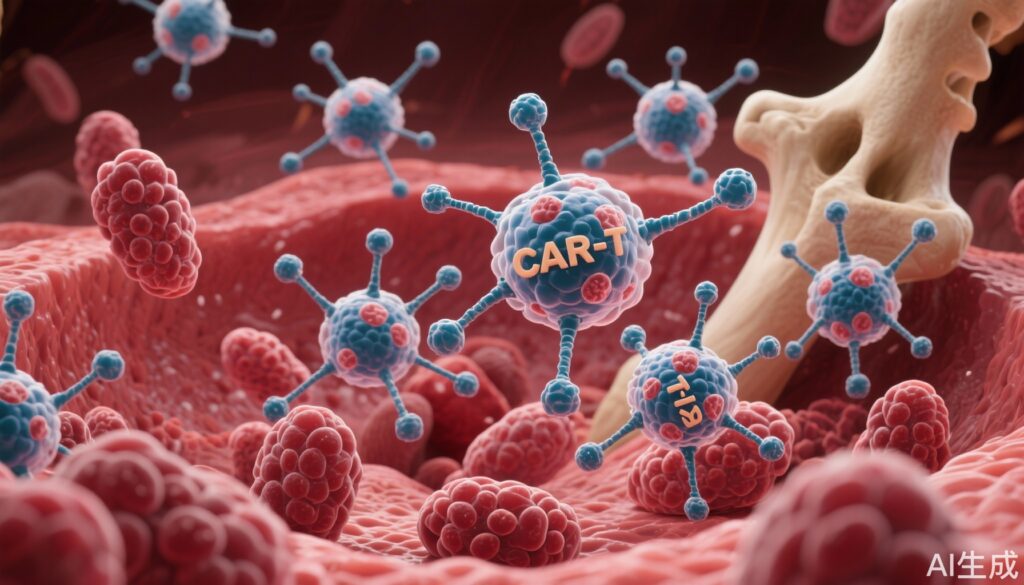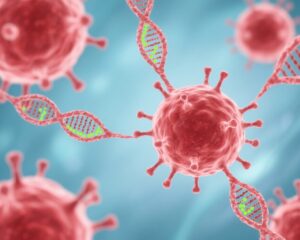Highlight
- FCARH143, a fully human BCMA-targeted CAR-T, demonstrated a 100% overall response rate in relapsed/refractory multiple myeloma (RRMM) patients, including 64% stringent complete response.
- Long-term follow-up of 5+ years showed sustained median progression-free survival of 15.5 months and overall survival of 32.1 months.
- Safety profile was manageable with no treatment-related deaths, and cytokine release syndrome and neurotoxicity rates were consistent with CAR-T therapies.
- Response rates were independent of disease burden or high-risk cytogenetics, supporting further development in high-risk RRMM populations.
Study Background and Disease Burden
Multiple myeloma is a malignancy of plasma cells with significant morbidity and mortality, particularly in patients who become relapsed/refractory (RRMM) to standard treatments. Despite advances with proteasome inhibitors, immunomodulatory agents, and monoclonal antibodies, RRMM remains a clinical challenge, especially in patients refractory to multiple drug classes and with extramedullary disease or high-risk cytogenetics. B-cell maturation antigen (BCMA) is a validated and highly specific target for novel immunotherapies in multiple myeloma. Chimeric antigen receptor T-cell (CAR-T) therapies targeting BCMA have shown promising efficacy; however, long-term durability, toxicity profiles, and the impact of humanized versus fully human CAR constructs require further elucidation. FCARH143 is a fully human single chain variable fragment-based BCMA CAR-T incorporating the 4-1BB costimulatory domain designed to optimize efficacy and minimize immunogenicity. This first-in-human phase 1 study investigates its safety, efficacy, and durability over a 5-year follow-up in heavily pretreated RRMM patients.
Study Design
This phase 1 open-label, dose-escalation trial enrolled 28 adult RRMM patients who had received a median of 8 prior therapies. Eligibility required evidence of relapsed/refractory disease with bone marrow plasma cell infiltration stratified into two groups (10%-30% or >30%). Patients underwent autologous leukapheresis for CAR-T cell manufacturing. Lymphodepleting chemotherapy was administered prior to infusion of escalating doses of FCARH143 CAR-T cells ranging from 50 × 10^6 to 450 × 10^6 cells. The primary endpoint was safety, focusing on cytokine release syndrome (CRS), neurotoxicity, and treatment-related adverse events. Secondary endpoints included overall response rate (ORR), duration of response, progression-free survival (PFS), and overall survival (OS). An intention-to-treat (ITT) analysis was performed to include all enrolled patients.
Key Findings
Of the 28 enrolled patients, all underwent leukapheresis and successful CAR-T cell manufacturing; however, 3 patients (11%) did not proceed to infusion due to disease progression or other reasons. Twenty-five patients received FCARH143 infusion; median age was 64 years, with 80% triple-class refractory (proteasome inhibitors, immunomodulatory agents, monoclonal antibodies) and 44% with extramedullary plasmacytomas, representing a high-risk cohort.
Safety outcomes showed cytokine release syndrome in 84% of treated patients, mostly grade 1-2, with 8% experiencing grade 3-4 CRS. Neurotoxicity occurred in 24%, with 12% grade 3 and no grade 4-5 events reported. Importantly, no treatment-related deaths occurred during the follow-up period, underscoring a manageable safety profile comparable to other BCMA-directed CAR-T products.
Efficacy was notably impressive: at a median follow-up of 67.3 months, all infused patients (100%) achieved a response to therapy, with stringent complete responses (sCR) in 64%. Median PFS was 15.5 months (95% CI not explicitly reported), and median OS was 32.1 months. The ITT analysis (median follow-up 69.6 months) confirmed an ORR of 89.3% and median OS of 30.2 months.
Subgroup analyses revealed that responses were independent of baseline disease burden (based on plasma cell infiltration levels) and cytogenetic risk status, highlighting robust antimyeloma activity regardless of traditional risk factors. Additionally, the durability of responses, with some patients maintaining remission beyond 5 years, supports potent long-term disease control.
Expert Commentary
This study provides valuable long-term data on a fully human BCMA CAR-T construct, helping to address concerns about immunogenicity seen with murine or humanized CAR-T designs. The 4-1BB co-stimulatory domain likely contributed to the observed persistence and durability of responses. The efficacy achieved in a heavily pretreated, high-risk population with extramedullary disease compares favorably with approved BCMA CAR-T products such as ide-cel and cilta-cel, which have reported ORRs of approximately 70-90% but with less mature long-term follow-up.
Moreover, the safety profile showing manageable CRS and neurotoxicity rates without fatal events is reassuring and supports broader clinical development.
Limitations of this phase 1 study include the small cohort size and absence of a control arm. While the dose-escalation design allowed for safety and efficacy assessment, future larger phase 2/3 trials are needed to confirm these findings and to assess comparative effectiveness. Additionally, mechanistic studies on CAR-T cell persistence, BCMA antigen escape, and immune microenvironment modulation could deepen understanding of response durability.
Conclusion
FCARH143, a fully human BCMA-targeted CAR-T therapy with a 4-1BB co-stimulatory domain, demonstrates potent and durable antimyeloma activity with an excellent safety profile in heavily pretreated patients with relapsed/refractory multiple myeloma. The 5-year follow-up data indicate sustained responses, including a high proportion of stringent complete remissions, and meaningful overall survival benefits independent of disease burden or high-risk cytogenetics. These promising results warrant further investigation in larger, controlled trials, especially targeting high-risk RRMM patients. FCARH143 represents a valuable addition to the evolving BCMA-directed immunotherapy landscape with the potential to improve long-term outcomes in multiple myeloma.



